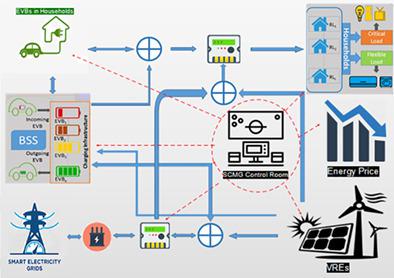当前位置:
X-MOL 学术
›
Int. J. Energy Res.
›
论文详情
Our official English website, www.x-mol.net, welcomes your
feedback! (Note: you will need to create a separate account there.)
Network overloading management by exploiting the in‐system batteries of electric vehicles
International Journal of Energy Research ( IF 4.3 ) Pub Date : 2020-11-16 , DOI: 10.1002/er.6207 Usama Rehman 1 , Donghan Feng 1 , Hao Su 1 , Muhammad Numan 1 , Farukh Abbas 1
International Journal of Energy Research ( IF 4.3 ) Pub Date : 2020-11-16 , DOI: 10.1002/er.6207 Usama Rehman 1 , Donghan Feng 1 , Hao Su 1 , Muhammad Numan 1 , Farukh Abbas 1
Affiliation

|
Network overloading and electric power shortfalls occur due to large variations in anticipated renewable electric power and electric loads, which may cause system overheating or network failure. A large portion of residential loads (RLs) comprises of electric vehicles (EVs); therefore, by using in‐system electric vehicle batteries (EVBs), above mentioned issues can be resolved. A lot of research has been done in this domain but the stochastic nature of this system has not been fully explored yet. In this article, an intelligent charging mechanism of EVs has been proposed for RLs. EVBs are charged during off‐peak hours and then batteries are utilized as an independent power source during peak hours to decrease stress on the power network. Vehicle‐to‐grid charging and discharging scenarios are considered, to optimize the rate of charging. A novel stochastic model predictive control (SMPC) framework, based on smart charging/discharging of EVBs has been proposed in this article. SMPC deals with the uncertain variations in the projected generation and demand of electric power, due to variable renewable energy and high electric loads, respectively. It deals with the discrepancy of supply, demand, and energy prices. Using SMPC, complex stochastic problems can be transformed into a simpler optimization problem, making it computation efficient and suitable for real‐time applications. To relax constraints on power demand, a worst case scenario technique has been used which reduces the computational cost of the system. Simulation results depict that controlled charging and discharging of EVBs in power grid network help reduce overshoots and undershoots of electric power demand in a smart community. Comparison of the proposed strategy has been done with benchmark algorithms, to show the competency of the proposed strategy. This study provides insight of a smart community microgrid operation and resultant trade‐offs to manage the demand and supply of electricity.
中文翻译:

通过利用电动汽车的内置电池进行网络过载管理
由于预期的可再生电力和电力负载变化较大,会导致网络过载和电力不足,这可能会导致系统过热或网络故障。很大一部分住宅负载(RLs)包括电动汽车(EV);因此,通过使用系统内电动汽车电池(EVB),可以解决上述问题。在这个领域已经做了大量的研究,但是这个系统的随机性还没有被完全探究。在本文中,提出了一种针对RL的电动汽车的智能充电机制。EVB在非高峰时段充电,然后在高峰时段将电池用作独立的电源,以减少对电网的压力。考虑了车辆到电网的充电和放电方案,以优化充电速率。本文提出了一种基于智能电动汽车充电/放电的新型随机模型预测控制(SMPC)框架。SMPC处理分别由于可变的可再生能源和高电力负荷而导致的预计发电量和需求的不确定性变化。它处理供应,需求和能源价格的差异。使用SMPC,可以将复杂的随机问题转换为更简单的优化问题,从而使其计算效率更高,并适合于实时应用。为了放松对功率需求的约束,已经使用了最坏情况的方案技术,该技术降低了系统的计算成本。仿真结果表明,电网中EVB的受控充电和放电有助于减少智能社区中电力需求的过冲和下冲。所提出的策略与基准算法进行了比较,以显示所提出策略的能力。这项研究提供了关于智能社区微电网运营及其在管理电力需求和供应方面的权衡取舍的见解。
更新日期:2020-11-16
中文翻译:

通过利用电动汽车的内置电池进行网络过载管理
由于预期的可再生电力和电力负载变化较大,会导致网络过载和电力不足,这可能会导致系统过热或网络故障。很大一部分住宅负载(RLs)包括电动汽车(EV);因此,通过使用系统内电动汽车电池(EVB),可以解决上述问题。在这个领域已经做了大量的研究,但是这个系统的随机性还没有被完全探究。在本文中,提出了一种针对RL的电动汽车的智能充电机制。EVB在非高峰时段充电,然后在高峰时段将电池用作独立的电源,以减少对电网的压力。考虑了车辆到电网的充电和放电方案,以优化充电速率。本文提出了一种基于智能电动汽车充电/放电的新型随机模型预测控制(SMPC)框架。SMPC处理分别由于可变的可再生能源和高电力负荷而导致的预计发电量和需求的不确定性变化。它处理供应,需求和能源价格的差异。使用SMPC,可以将复杂的随机问题转换为更简单的优化问题,从而使其计算效率更高,并适合于实时应用。为了放松对功率需求的约束,已经使用了最坏情况的方案技术,该技术降低了系统的计算成本。仿真结果表明,电网中EVB的受控充电和放电有助于减少智能社区中电力需求的过冲和下冲。所提出的策略与基准算法进行了比较,以显示所提出策略的能力。这项研究提供了关于智能社区微电网运营及其在管理电力需求和供应方面的权衡取舍的见解。









































 京公网安备 11010802027423号
京公网安备 11010802027423号